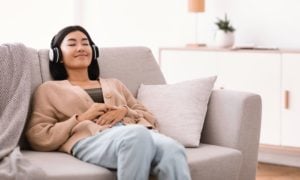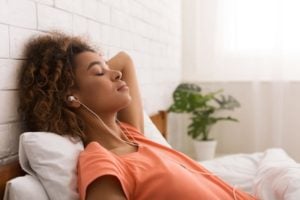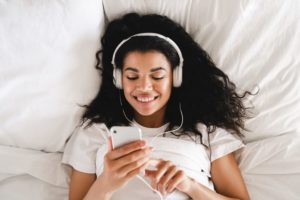ASMR for Sleep: How It Works and Triggers to Try
Autonomous sensory meridian response (ASMR) describes the deep relaxation and pleasant scalp and neck tingling some people feel in response to quiet sounds such as whispering, or quiet sounds combined with gentle movements and personal attention. This phenomenon was only named in 2010, but it has gained significant traction online among people who claim that activating this response helps them relax and sleep better.
About one in five people are capable of experiencing this sensory phenomenon, and if you are among them, you may be able to harness its benefits to help you sleep. We cover what ASMR is, how ASMR works for sleep, and tips for incorporating ASMR into your nightly routine.
What Is ASMR?
The Autonomous Sensory Meridian Response (ASMR) causes a static-like feeling to spread from the scalp down the spine in response to particular sensory triggers. This feeling is distinctly pleasurable and is often accompanied by an altered state of consciousness characterized by intense relaxation, present moment awareness, and euphoria.

While triggers vary from person to person, they typically consist of specific physical sensations, sounds, imagery, or interpersonal interactions—or some combination of those inputs. Generally, it is a calming or pleasurable response to visual, auditory, tactile, olfactory or cognitive stimuli. ASMR tends to be a sought-after experience not only because it produces enjoyable sensations and emotions, but also because many people report that it helps them sleep or manage conditions such as depression, anxiety, and chronic pain.
Researchers began studying ASMR in the last decade, in part because of a social media boom dedicated to describing the phenomenon and to sharing videos and sound clips intended to trigger ASMR. While the scientific understanding of ASMR is incomplete and still evolving, experts suggest it can have a positive impact on health and wellbeing.
How ASMR Works For Sleep
Bedtime is by far the most popular time to induce ASMR as many people report using it as a sleep aid. ASMR has been shown to trigger feelings of pleasure and relaxation, which can increase hormones such as dopamine and oxytocin. As a result, ASMR has been shown to improve sleep quality. There are several pathways by which ASMR can help with sleep, including:
- Promoting relaxation: The most widely reported effect of ASMR is relaxation. Feeling relaxed is an important precursor to sleep, as it allows the body to release tension and the mind to settle.
- Reducing anxiety and stress: Anxiety and stress can make it hard to fall asleep and stay asleep. ASMR reduces anxiety and stress levels, and it may aid sleep by preventing users from dwelling on stressful thoughts at bedtime.
- Elevating mood: There is a well established link between depression and sleep problems. ASMR appears to improve mood, which may help alleviate sleep difficulties in people with depression.
- Reducing pain: Pain can interfere with sleep, but ASMR has been shown to provide temporary pain relief.
Relaxing ASMR Triggers to Try
ASMR users and researchers have documented many triggers, ranging from the sound of chopping vegetables, to the sensation of having makeup applied, to the experience of watching slime move. However, what triggers ASMR for one person might not for another—and, in some cases, might even elicit annoyance or disgust.
That said, certain stimuli are more likely than others to trigger ASMR. For example, physical touch has a higher likelihood of inducing ASMR than audio or visual triggers—and it’s more likely to induce high-intensity sensations. Similarly, sounds generated by human activity are more likely to trigger ASMR than sounds generated in nature.
If you are searching for ASMR triggers to help you sleep, consider trying some shown by studies to work for most ASMR users:
- Touch-based and interpersonal triggers: Have a trusted partner, friend, or family member gently touch your face, stroke your hair, give you a massage, or make eye contact with you.
- Sound-based triggers: There are many recordings and videos available online of sounds intended to induce ASMR. Try playing one that features whispering or soft voices, brushing or sweeping noises, tapping, clicking, crunching, crinkling, the sounds of liquids pouring, or natural soundscapes.
- Visual triggers: Play a video focused on gentle hand movements, someone else receiving caring touches, or someone completing a technical or artistic task that takes great concentration.
How to Use ASMR for Sleep
If you want to use ASMR as a tool for falling asleep, there are several steps you can take to set yourself up for success.
- Figure out your triggers. Experiment with a variety of triggers, and determine which ones induce ASMR, relaxation, and feelings of sleepiness.
- Do not bring worries to bed. If you have stress or worries, set aside time before bedtime to explore these feelings. Consider writing these concerns in a journal before going to bed.
- Commit to a bedtime routine. A regular bedtime routine, conducted at the same time every night, signals to your body that it’s time to sleep. Consider when and how to incorporate ASMR into your bedtime routine.
- Assemble what you need. Whether you need to download a sleep app or to purchase headphones so that you don’t disturb your bed partner, make sure to gather everything you need for ASMR beforehand.
- Limit exposure to blue light. Devices with screens emit blue light, which can interfere with sleep. If you can, use a touch- or sound-based ASMR trigger that allows you to avoid screens. If you prefer visual triggers, consider using blue light-blocking glasses.
- Consider your sleep environment. Before engaging in ASMR, make sure your bedroom is cool, dark, and quiet, so you can drift off to sleep as soon as you are ready.
While many people praise ASMR’s effectiveness as a sleep aid, it is important to know that ASMR cannot solve all sleep problems. If you regularly have trouble sleeping or frequently experience daytime tiredness, talk to your doctor about your symptoms.

Still have questions? Ask our community!
Join our Sleep Care Community — a trusted hub of sleep health professionals, product specialists, and people just like you. Whether you need expert sleep advice for your insomnia or you’re searching for the perfect mattress, we’ve got you covered. Get personalized guidance from the experts who know sleep best.
References
5 Sources
-
Shimokura R. (2022). Sound Quality Factors Inducing the Autonomous Sensory Meridian Response. Audiology research, 12(5), 574–584.
https://pubmed.ncbi.nlm.nih.gov/36285913 -
Barratt, E. L., & Davis, N. J. (2015). Autonomous sensory meridian response (ASMR): A flow-like mental state. PeerJ, 3, e851.
https://pubmed.ncbi.nlm.nih.gov/25834771/ -
Eid CM, Hamilton C, Greer JMH (2022) Untangling the tingle: Investigating the association between the Autonomous Sensory Meridian Response (ASMR), neuroticism, and trait & state anxiety. PLoS ONE 17(2): e0262668.
https://journals.plos.org/plosone/article?id=10.1371/journal.pone.0262668 -
Smejka, T., & Wiggs, L. (2022). The effects of Autonomous Sensory Meridian Response (ASMR) videos on arousal and mood in adults with and without depression and insomnia. Journal of affective disorders, 301, 60–67.
https://pubmed.ncbi.nlm.nih.gov/34915083/ -
Poerio, G. L., Succi, A., Swart, T., Romei, V., & Gillmeister, H. (2023). From touch to tingles: Assessing ASMR triggers and their consistency over time with the ASMR Trigger Checklist (ATC). Consciousness and cognition, 115, 103584.
https://pubmed.ncbi.nlm.nih.gov/37820451/






